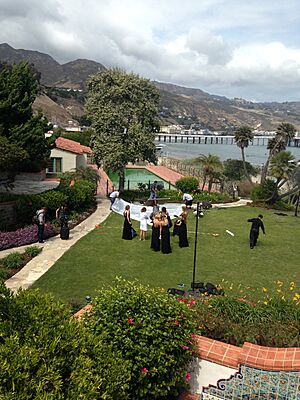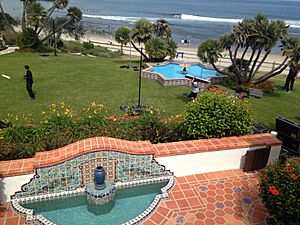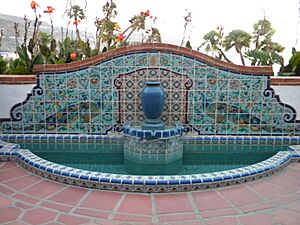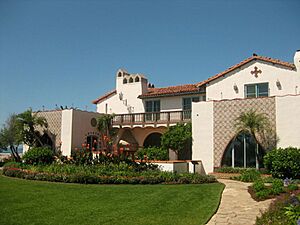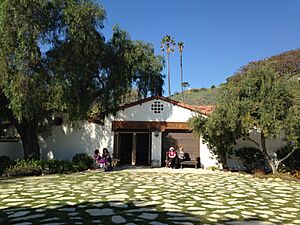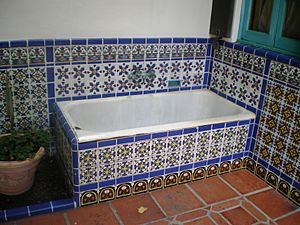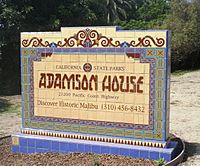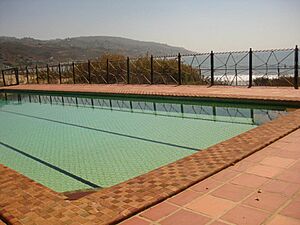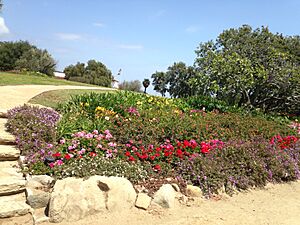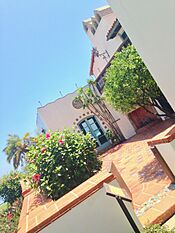Adamson House facts for kids
Quick facts for kids |
|
|
Adamson House
|
|

Adamson House
|
|
| Location | 23200 W. Pacific Coast Highway, Malibu, California |
|---|---|
| Built | 1929 (family moved in during June 1930) |
| Architect | Stiles O. Clements |
| Architectural style | Mediterranean or Spanish-Moorish |
| NRHP reference No. | 77000298 |
| Added to NRHP | October 28, 1977 |
The Adamson House is a beautiful historic home and garden located in Malibu, California. It sits right on the coast, inside the Malibu Lagoon State Beach park. People sometimes call it the "Taj Mahal of Tile" because it has so many amazing decorative ceramic tiles. These tiles were made by Rufus Keeler at Malibu Potteries.
The house was built in 1929 for Rhoda Rindge Adamson and Merritt Huntley Adamson. It was designed in a Mediterranean Revival style by Stiles O. Clements. The Adamson House became a California Historical Landmark in 1977 and was added to the National Register of Historic Places in 1985.
Contents
A Look at the Adamson Family History
The Rindge and Adamson Families
Frederick Hastings Rindge was a rich businessman from Boston who moved to Los Angeles. He owned a huge area called the "Rindge Ranch," which included much of what is now Malibu. His daughter was Rhoda Agatha Rindge Adamson.
Merritt Adamson (1888–1949) studied law at the University of Southern California. He was even the captain of the 1912 football team, which was the first USC team to be called the "Trojans." Merritt met Rhoda Rindge while working as a foreman on her family's ranch. They got married in 1915. In 1916, Merritt started a dairy business in the San Fernando Valley called Adohr Farms. He named it by spelling his wife's name, Rhoda, backward! This business grew to be one of the biggest dairies in the country.
Building the Adamson House
The Adamson House has two stories and ten rooms. Stiles O. Clements designed it, and it was finished in 1930. The house is a great example of a Spanish Colonial Revival and Moorish Revival architecture style. Inside, you'll find red tile floors, special windows, wooden beams, and molded walls.
The house also features beautiful teak wood, cozy fireplaces, and hand-painted ceilings. The windows have lead-framed bottle glass and fancy wrought-iron designs. The main living room is very large with windows on three sides. It still has the original furniture, including the big radio where the family heard news about the attack on Pearl Harbor.
Other rooms on the main floor include a guest bedroom with a bathroom covered in tiles from floor to ceiling. There's also a dining room with an old convent table that looks out at the ocean. The kitchen has an early version of a dishwasher and a colorful tiled clock. The house even has an elevator!
Upstairs, there are four bedrooms and a small kitchenette. The main bedroom, where Mr. and Mrs. Adamson slept, has a large tiled bathroom. Mrs. Adamson's clothes and hat collection are still in her closet. Next to it is their son's bedroom, with detailed tiles showing ships and ocean scenes. The girls' bedroom faces the ocean and has an amazing view. These three bedrooms open onto a large upstairs patio with incredible views of the ocean and coast.
The house also had a special tiled swimming pool right on the sand. It could be filled with either salt or fresh water using a special filter and heater. In 1930, The Los Angeles Times said it was "one of the finest" pools in Southern California!
A Showcase of Malibu Tiles
The Adamson House is famous for its many beautiful Malibu tiles. In 1926, May K. Rindge (Rhoda Adamson's mother) started a tile factory near the Malibu Pier. Rufus Keeler, a talented ceramic engineer, ran the factory. He worked with local artists to create unique decorative tiles. The factory employed over 100 people in the late 1920s and made some of the most colorful tiles in the country.
Special hand-crafted tiles, made from local clay, were designed for each room of the Adamson House. Even the ceiling of one bathroom was tiled! In 1930, the Los Angeles Times wrote about the "striking tile effects" from the pottery's artists. Many years later, the Los Angeles Times still called it "the house that tile built" because tile is everywhere.
One of the most popular tile designs is a 60-foot (18 m) long tile "Persian carpet" that even has small pieces designed to look like rug fringes. Outside, the colorful Neptune Fountain, Peacock Fountain, and Star Fountain are often photographed. There's also a fancy tiled outdoor tub that the Adamsons used to bathe their dogs! The bathhouse and swimming pool are also covered in Malibu tile. The house is truly a "museum of tile." Malibu Potteries only operated for six years, from 1926 to 1932, so the Adamson House holds many of its most important remaining works.
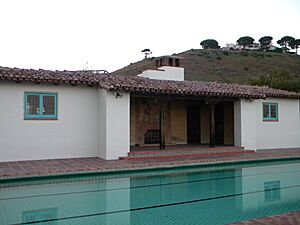
Early Life at the House
The Adamson House was first a vacation home, but the Adamsons eventually made it their permanent residence. In December 1932, a fire started in the garage's electrical wiring. One bedroom was badly damaged, but firefighters from nearby stations quickly put out the flames. During World War II, the bathhouse was used by the United States Coast Guard as a local office to watch over the Malibu coast.
Saving the Adamson House
After her husband passed away, Rhoda Rindge Adamson lived in the house until her death in April 1962. Her family then planned to build a large beach resort on the 13-acre (53,000 m2) property, while keeping the house as a museum. However, the State of California wanted to buy the land to create beach parking. They used a legal process called eminent domain to purchase the property in 1966.
Even though the state bought the property, many people wanted to save the Adamson House. The Malibu Historical Society, along with the Los Angeles County Department of Parks and Recreation and the Adamson family, worked hard for ten years to preserve it. While the state's parking plans were on hold, Pepperdine University leased the house from 1971 to 1982 for its chancellor to live in.
In 1976, preservationists won a big victory when the director of the state's Department of Parks and Recreation decided to save the entire property instead of turning it into parking. Sylvia Rindge Adamson Neville, a granddaughter of Frederick Rindge, donated money to help restore the house. More funds were raised by the Malibu Historical Society. In October 1982, volunteers began turning the garage into a small history museum. Finally, in 1983, the Adamson House and the Malibu Lagoon Museum (in the garage) opened to the public for tours.
Adamson House in Pop Culture
The Adamson House has been featured in several TV shows:
- In 1975, it appeared in the Mannix episode "A Word Called Courage."
- From 1987 to 1989, it was used as Abby Ewing's house in seasons eight and ten of Knots Landing.
- In 2020, the house was featured in the Netflix show Ratched.
- In 1985, it was in the Dallas episode "Deeds and Misdeeds" from Season 8.
- In 1986, the house was a party house in the Season 3 episode of Airwolf called “Hawke’s Run."
- The home was featured in the Season 1 episode titled "The Mexican Connection" from Charlie's Angels.
Historic Recognition
The Adamson House was listed on the National Register of Historic Places in October 1977. In November 1985, it was also named a California Historical Landmark by the California Historic Resources Commission.
The California Historical Landmark Marker NO. 966 at the site explains: NO. 966 ADAMSON HOUSE AT MALIBU LAGOON STATE BEACH - This home, designed by Stiles O. Clements in 1929, is a great example of Spanish Colonial Revival style. It has the best remaining decorative ceramic tiles made by Malibu Potteries. From 1926 to 1932, Malibu Potteries created many artistic and colorful tiles. The home was built for Merritt Huntley Adamson and Rhoda Rindge Adamson. Rhoda was the daughter of Frederick Hastings Rindge and May Knight Rindge, who were the last owners of the large Rancho Malibu Spanish land grant.
More to Explore






